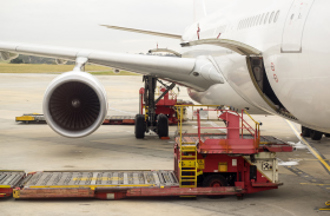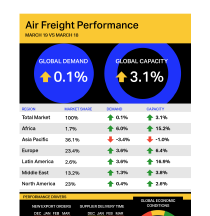
Translation:
Le transport de fret aérien demeure faible (pdf)
Continúa la debilidad en el sector de transporte de carga aérea en marzo (pdf)
Continua fraca demanda por transporte aéreo de carga (pdf)
国际航协:全球航空货运需求持续疲软 (pdf)
عودة معدلات الطلب على الشحن الجوي إلى الجانب الإيجابي خلال شهر مارس 2019 (pdf)
Geneva - The International Air Transport Association (IATA) released data for global air freight markets showing that demand, measured in freight tonne kilometers (FTKs), increased 0.1% in March 2019, compared to the same period in 2018. While this is a significant improvement on the 4.9% contraction in February, in seasonally adjusted terms, demand is still down 1.5% over the past year.
Freight capacity, measured in available freight tonne kilometers (AFTKs), rose by 3.1% year-on-year in March 2019. Capacity growth has now outstripped demand growth for 11 out of the last 12 months.
Demand for air cargo continues to face significant headwinds:
- Global trade volumes have fallen by 1% over the past year;
- Global economic activity and consumer confidence continue to weaken;
- And the export order component of the global manufacturers Purchasing Managers Index (PMI) has indicated falling global export orders since September 2018.
Industry confidence regarding the outlook, however remains relatively upbeat with only 13% of respondents from IATA’s Business Confidence Survey expecting to see a decrease in freight volumes in 2019 compared to 2018.
“Year-on-year demand for air freight edged back into positive territory in March with 0.1% growth. After four consecutive months of contraction, this is an encouraging development. But the headwinds from weakening global trade, growing trade tensions and shrinking order books have not gone away,” said Alexandre de Juniac, IATA's Director General and CEO.
| march 2019 (% year-on-year) | World share1 | ftk | AftK | fLF (%-pt)2 | fLF (level)3 |
|---|---|---|---|---|---|
| Total Market | 100.0% | 0.1% | 3.1% | -1.5% | 49.5% |
| Africa | 1.7% | 6.0% | 15.2% | -3.3% | 38.4% |
| Asia Pacific | 36.1% | -3.4% | -1.0% | -1.4% | 55.6% |
| Europe | 23.4% | 3.6% | 6.4% | -1.5% | 56.0% |
| Latin America | 2.6% | 3.6% | 16.9% | -4.2% | 32.3% |
| Middle East | 13.2% | 1.3% | 3.8% | -1.2% | 48.8% |
| North America | 23.0% | 0.4% | 2.6% | -0.9% | 41.6% |
Regional Performance
All regions reported year-on-year demand growth in March 2019, except Asia-Pacific which contracted.
Asia-Pacific airlines saw demand for air freight shrink by 3.4% in March 2019, compared to the same period in 2018. This was a significant improvement from the 12.0% decline in growth from the previous month. Weaker manufacturing conditions for exporters in the region, ongoing trade tensions and a slowing of the Chinese economy impacted the market. Capacity decreased by 1.0%.
North American airlines saw demand increase by 0.4% in March 2019, compared to the same period a year earlier. The recent easing of growth is partly due to a slowing of US domestic economic activity in the later part of 2018 and falling global trade volumes. Despite this, new export orders are rising which would support air cargo growth. Capacity increased by 2.6% over the past year.
European airlines posted a 3.6% increase in freight demand in March 2019 compared to the same period a year earlier. Given the weaker manufacturing conditions for exporters in Germany, and uncertainty over Brexit, March’s performance represents a positive outcome. Capacity increased by 6.4% year-on-year.
Middle Eastern airlines’ freight volumes increased 1.3% in March 2019 compared to the year-ago period. Capacity increased by 3.8%. A clear downward trend in seasonally-adjusted international air cargo demand is now evident with weakening air freight volumes to/from North America and to/from Asia Pacific contributing to the softer performance.
Latin American airlines experienced an increase in freight demand growth in March 2019 of 3.6% compared to the same period last year and capacity increased by 16.9%. The emergence of the Brazilian economy from recession is supporting a resurgence in air cargo demand. Nevertheless, ongoing economic and political uncertainties in various parts of the region continue to present challenges for the industry.
African carriers posted the fastest growth of any region in March 2019, with an increase in demand of 6.0% compared to the same period a year earlier. Seasonally-adjusted international freight volumes are lower than their peak in mid-2017; despite this, they are still around 30% higher than their most recent trough in late-2015. Capacity grew 15.2% year-on-year.
View the full infographic (pdf)
Read the full Freight Analysis for March (pdf)
For more information, please contact:
Corporate Communications
Tel: +41 22 770 2967
Email: corpcomms@iata.org
Notes for Editors:
- IATA (International Air Transport Association) represents some 290 airlines comprising 82% of global air traffic.
- You can follow us at http://twitter.com/iata for news specially catered for the media.
- Explanation of measurement terms:
- FTK: freight tonne kilometers measures actual freight traffic
- AFTK: available freight tonne kilometers measures available total freight capacity
- FLF: freight load factor is % of AFTKs used
- IATA statistics cover international and domestic scheduled air freight for IATA member and non-member airlines.
- Total freight traffic market shares by region of carriers in terms of FTK are: Asia-Pacific 35.5%, Europe 23.3%, North America 23.6%, Middle East 13.3%, Latin America 2.6%, and Africa 1.7%.

